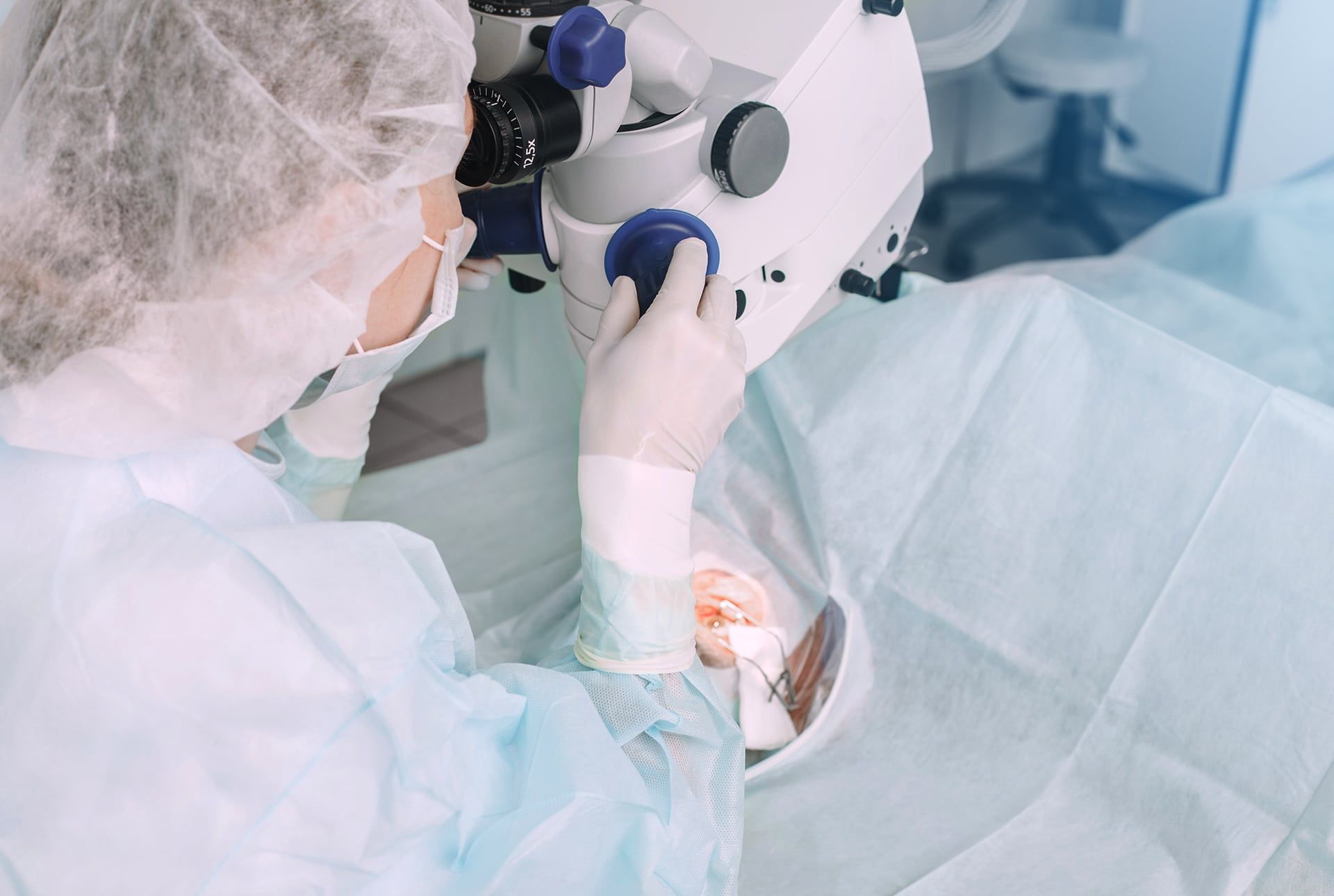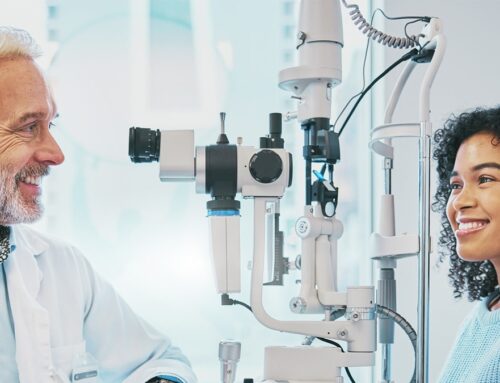Cataracts are a common eye condition that occurs when the lens of the eye becomes cloudy or opaque, causing vision loss. Treatment for cataracts typically involves surgery to remove the cloudy lens and replace it with a clear artificial lens. This procedure is called cataract surgery, and it is typically performed by an ophthalmologist, a medical doctor who specializes in the treatment of eye conditions.
In this article we’ll discuss some background information about cataracts, how cataracts are treated, and when you might consider treating them.
What is a cataract?
A cataract is a condition in which the lens of the eye becomes cloudy, making it difficult to see clearly. This cloudiness can cause vision to become blurry or hazy, and can make colors appear less vibrant. Cataracts are a common cause of vision loss in older adults, but they can also develop in younger people as a result of injury, certain medications, or other underlying health conditions. Treatment for cataracts typically involves surgical removal of the cloudy lens and replacement with a clear artificial lens.
Cataract Symptoms
One of the most common symptoms of cataracts is blurred vision. This can occur in one or both eyes and can range from mild to severe. People with cataracts may also experience difficulty seeing at night, increased sensitivity to glare, and the appearance of halos around lights.
Other symptoms of cataracts include double vision, a change in the way colors appear, and the need for brighter lighting to see properly. Some people may also experience frequent changes in eyeglass or contact lens prescriptions, and frequent changes in the appearance of glasses or contact lenses.
In advanced cases of cataracts, people may experience a complete loss of vision in the affected eye. This can lead to a loss of independence and an inability to perform everyday activities, such as driving or reading.
If you are experiencing any of these symptoms, it is important to see an eye doctor for a thorough examination. Cataracts can be treated with surgery, which can help improve vision and restore independence. Early detection and treatment are key to preventing the progression of cataracts and maintaining good vision.
How are cataracts diagnosed?
Cataracts are typically diagnosed by an eye doctor during a comprehensive eye examination. The doctor will first ask about your medical history and any symptoms you are experiencing. They will then perform a number of tests to evaluate your vision and the health of your eyes.
One of the tests used to diagnose cataracts is a visual acuity test, which measures how well you can see. This is typically done using a standard eye chart, where you are asked to read letters of different sizes from a distance. The doctor may also use a device called a slit lamp to examine the front of your eye and look for any signs of cataracts.
Another common test for cataracts is called a refraction test, which is used to determine the strength of your eyeglass prescription. A progressively changing glasses prescription can be a sign of cataracts.
Cataract Treatment
Cataracts are typically treated with surgery to remove the clouded lens and replace it with an artificial lens. This procedure is called cataract surgery and is one of the most common and successful types of surgery performed in the United States.
Cataract surgery is typically performed on an outpatient basis, which means you can go home the same day. The procedure is usually done under local anesthesia, which numbs the area around your eye.
During the surgery, your doctor will make a small incision in your eye and use a special tool called an ultrasound to break up the clouded lens. The pieces of the lens are then suctioned out of the eye. Once the clouded lens has been removed, the doctor will insert a new artificial lens, called an intraocular lens (IOL), into your eye. The IOL is made of a special material that is designed to mimic the natural lens of the eye.
After the surgery, your eye will be covered with a protective shield to help it heal. You will need to use eye drops for a few weeks to help prevent infection and inflammation. Most people experience significant improvements in their vision within a few days of the surgery, although it may take a few weeks for your vision to fully stabilize.
Cataract surgery is generally safe and effective, and most people experience significant improvements in their vision after the procedure. However, as with any surgery, there are some risks involved, including infection, inflammation, and bleeding. Your doctor can discuss the potential risks and benefits of the surgery with you in more detail.
Lens Implants to Treat Cataracts
There are several types of lens implants that can be used during cataract surgery. The type of implant that is best for you will depend on your individual needs and preferences.
One common type of lens implant is a monofocal lens, which is designed to help you see clearly at one distance. This type of lens is typically used to improve distance vision, so you can see things clearly when looking at objects that are far away.
Another option is a multifocal lens, which is designed to help you see clearly at multiple distances. This type of lens can improve your vision for both near and far distances, which can be helpful if you have presbyopia (age-related difficulty seeing objects up close).
There are also toric lens implants, which are designed to correct astigmatism (a condition that causes blurry vision at all distances). Toric lenses can help improve your vision for both near and far distances, and can be used in combination with other types of lens implants.
Your doctor can help you determine which type of lens implant is best for you based on your individual needs and preferences. They can also provide more information about the benefits and risks of each type of lens implant.
Can Eye drops be used to treat cataracts?
Eye drops cannot be used to treat cataracts. Cataracts are caused by the clouding of the lens in the eye, and cannot be reversed with medications or eye drops.
The only effective treatment for cataracts is surgery to remove the clouded lens and replace it with an artificial lens. This procedure is called cataract surgery and is typically performed by an ophthalmologist (a doctor who specializes in eye care).
When should you have your cataracts treated?
The decision to treat cataracts is typically based on how much they are affecting your vision and quality of life. In most cases, cataracts are not treated until they start to interfere with your ability to see and perform everyday activities.
If you are experiencing symptoms of cataracts, such as blurred vision, difficulty seeing at night, or sensitivity to glare, it is important to see an eye doctor for a thorough examination. They can evaluate your vision and the health of your eyes and determine if you have cataracts and whether treatment is necessary.
In general, cataracts are treated when they start to interfere with your ability to see and perform everyday activities, such as driving, reading, or watching television. The timing of the surgery will depend on the severity of your symptoms and how much they are affecting your vision and quality of life.
If you are experiencing symptoms of cataracts, it is important to talk to your doctor about your options and the potential benefits and risks of cataract surgery. They can help you make an informed decision about the best course of treatment for your condition.
Do cataracts grow back?
No, cataracts do not grow back after they have been removed. Cataracts are caused by the clouding of the lens in the eye, and once the clouded lens is removed, it cannot grow back.
Cataract surgery involves removing the clouded lens and replacing it with an artificial lens. This procedure is typically very successful at improving vision and reducing symptoms, such as blurred vision and difficulty seeing at night.
After the surgery, the artificial lens will remain in place and will not be subject to the same changes that can cause cataracts to develop. However, it is still important to maintain good eye health and see your doctor for regular check-ups to ensure that your eyes are healthy and functioning properly.
In some cases, people who have had cataract surgery may develop a condition called posterior capsule opacification (PCO), which is a clouding of the back part of the artificial lens. This condition can cause blurry vision and is typically treated with a laser procedure called YAG laser capsulotomy. This procedure is typically quick and painless and can restore clear vision.
Overall, cataracts do not grow back after they have been removed, but it is important to maintain good eye health and see your doctor for regular check-ups to ensure that your eyes are healthy and functioning properly.











